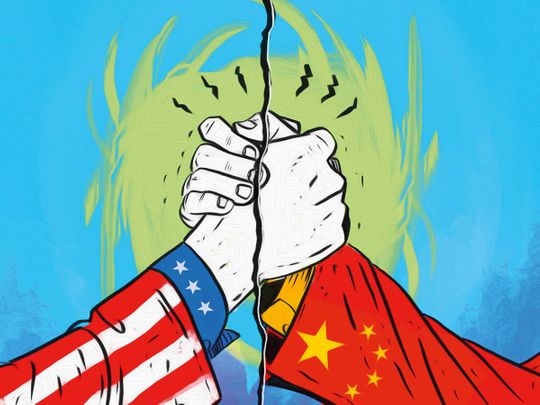
In a virtual meeting on 12 March — Biden’s first, clearly meant to stem the rising China challenge, the leaders of the four ‘democracies’ — the United States, Japan, India and Australia, commonly known as the ‘Quad’, decided to prepare a 1 billion Coronavirus vaccine doses for the ASEAN and the Asia-Pacific region before the end of 2022.
The four also decided to meet in person before the end of the year by which time working groups set up on 5G, artificial intelligence and cyber security are expected to be ready with their reports.
Evading focus on China, Jake Sullivan, the US National Security Advisor told the media that the meeting touched upon “freedom of navigation in the East and South China Seas.”
He added that “we’re renewing our commitment to ensure that our region is governed by international law, committed to upholding universal values, and free from coercion.”
China’s maritime lifeline
Several states led by the US have raked up a dispute with China since it declared much of South China Sea (SCS) as its territorial waters. China, having guaranteed the civilian maritime passage, has serious reservations over the American naval presence in the SCS, which is China’s maritime lifeline.
Biden who, as a candidate, called for rebuilding of America’s alliances, reinvigorating the ‘Quad’ that virtually lay dormant for nearly a decade sets the tone where his priorities lie in future. The four ‘democracies’ had never met at the summit level before. The real purpose of the ‘Quad’ is how to minimise China’s growing influence and contain its rise.
To militarily confront China can be disastrous for the regional states and Asia in general. The answer lies in accommodating China’s rise and managing it peacefully for the benefit of mankind. We are witnessing an era of historic passing of the baton
The Chinese news media criticised the summit. These countries, the papers argued, has China as their largest trading partner and share the Asian and Oceanic space with it, whereas the US is the outside power exercising primacy in the region as a post-World War II legacy.
This virtual summit meeting, comes at a time when relations between the US and these countries and China are under stress. Starting with the Trump administration’s trade war against China it has taken a different form with the three.
Two military standoffs between China and India could well be considered a part of hardening of attitudes towards China by these states. Australia kowtowed the US and publicly called for an independent inquiry over the origins of coronavirus, which drew swift and strong Chinese reaction.
With over 30 per cent of Australian exports going to China alone, leading to the longest sustained growth in Australian economy, no pragmatic policymaker would have done that. The Chinese do not appreciate diplomacy in public. You do that, you draw the Chinese retribution which Australia saw in ban of some of its exports to China.
In addition to the historical baggage, Japan too disturbed the status quo by taking state control of Senkaku Islands in 2012 and bring them at the Centre of the dispute between the two.
China's formidable presence
The Chinese call them Diaoyu Islands. The islands had been under a private ownership and China despite laying claims on them was content with the status quo.
Since 2012 these islands are considered high risk of militarised conflict between China and Japan. And as it usually happens, after sitting quiet since WWII, over the competing territorial claims the US entered the fray stating that the islands fall under the US-Japan Treaty of Mutual Cooperation and Security. It has never been the same between China and Japan since then.
The ‘democracies’ are angry too at China’s phenomenal model of growth. American attitudes have changed because they have seen China leapfrog over the US in many sectors. Open competition the US thought, will be enough to quell China’s growth.
The opposite has happened. With 40 years of unparalleled growth in human history, China has lifted 800 million Chinese above the poverty line. China has become the “factory of the world” in process.
The trouble with the Quad states is that they all promote — “a free, open and inclusive Indo-Pacific region.” In effect this means a region that should continue to be dominated by the US at the expense of China, which as the state poised to become the world’s largest economy is claiming its rightful place in its front yard.
Also, this new term ‘Indo-Pacific’ put in usage since 2011 replacing the historically accepted “Asia-Pacific”. According to the Wikipedia it has a “symbiotic link with the Quad” and has been floated to initiate change in “mental maps” of how the world is understood in strategic terms.
China has a formidable presence in the region — geographically and demographically. The US may still be number one economy but China is a close second and overtaking. No regional state can afford to take sides in a dispute in which China looms large.
To militarily confront China can be disastrous for the regional states and Asia in general. The answer lies in accommodating China’s rise and managing it peacefully for the benefit of mankind. We are witnessing an era of historic passing of the baton.
Sajjad Ashraf served as an adjunct professor at the Lee Kuan Yew School of Public Policy, National University of Singapore from 2009 to 2017. He was a member of Pakistan Foreign Service from 1973 to 2008 and also served as Pakistan’s consul general to Dubai during the mid 1990s.





